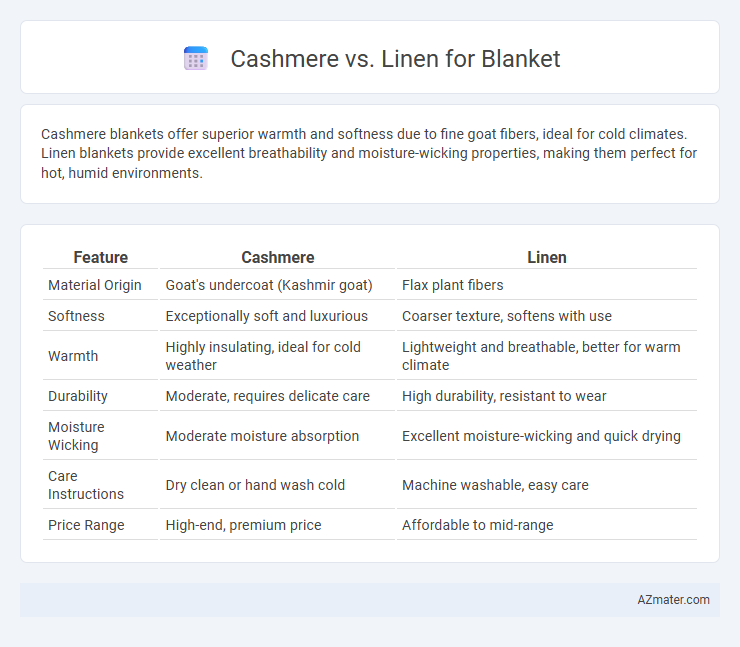Cashmere blankets offer superior warmth and softness due to fine goat fibers, ideal for cold climates. Linen blankets provide excellent breathability and moisture-wicking properties, making them perfect for hot, humid environments.
Table of Comparison
| Feature | Cashmere | Linen |
|---|---|---|
| Material Origin | Goat's undercoat (Kashmir goat) | Flax plant fibers |
| Softness | Exceptionally soft and luxurious | Coarser texture, softens with use |
| Warmth | Highly insulating, ideal for cold weather | Lightweight and breathable, better for warm climate |
| Durability | Moderate, requires delicate care | High durability, resistant to wear |
| Moisture Wicking | Moderate moisture absorption | Excellent moisture-wicking and quick drying |
| Care Instructions | Dry clean or hand wash cold | Machine washable, easy care |
| Price Range | High-end, premium price | Affordable to mid-range |
Introduction to Cashmere and Linen Blankets
Cashmere blankets, crafted from the ultra-soft undercoat of cashmere goats, offer exceptional warmth and luxurious softness, making them ideal for cold climates. Linen blankets, made from the fibers of the flax plant, provide breathability and durability, excelling in moisture-wicking and temperature regulation for year-round comfort. Both materials present unique benefits, with cashmere emphasizing plush insulation and linen highlighting natural coolness and strength.
Natural Origins and Production Processes
Cashmere blankets originate from the fine undercoat fibers of cashmere goats, primarily found in Mongolia and China, harvested through careful combing during the molting season to ensure softness and durability. Linen blankets are made from flax plant fibers grown mainly in Europe, where the flax is harvested, retted to separate fibers, and then spun into yarn, resulting in a breathable and strong fabric. The natural, labor-intensive harvesting and processing of cashmere offer exceptional warmth and luxury, while linen's plant-based production emphasizes eco-friendliness and moisture-wicking properties.
Texture and Feel: Softness Comparison
Cashmere blankets offer an ultra-soft, luxurious texture with a smooth, silky feel that provides exceptional warmth without bulk. Linen blankets feature a naturally breathable and slightly coarse texture, delivering a fresh, crisp feel ideal for warmer climates. The softness of cashmere is unmatched for cozy comfort, while linen excels in durability and a cool, airy sensation.
Warmth and Insulation Differences
Cashmere blankets provide superior warmth and insulation due to the fine, soft fibers that trap body heat effectively, making them ideal for cold climates. Linen blankets, made from flax fibers, offer breathability and moisture-wicking properties, which result in moderate insulation suitable for milder temperatures. The natural thermal regulation of linen allows it to stay cool in heat while providing lightweight warmth, contrasting with cashmere's dense fiber structure designed for maximum heat retention.
Breathability and Moisture Wicking
Cashmere blankets offer exceptional softness with moderate breathability, making them warm but less effective at moisture wicking compared to linen. Linen blankets excel in breathability due to their natural flax fibers, allowing superior airflow and quick moisture evaporation, which helps keep users cool and dry. For those prioritizing moisture-wicking properties and temperature regulation, linen provides a more breathable and moisture-resistant option than cashmere.
Durability and Longevity
Cashmere blankets offer exceptional softness but require delicate care to maintain their durability, as they are more prone to pilling and wear over time compared to linen. Linen blankets are highly durable, known for their strong natural fibers that become softer with each wash while retaining structural integrity and resistance to tearing. The longevity of linen blankets generally surpasses cashmere, making them ideal for long-term use with minimal maintenance.
Allergen and Sensitivity Considerations
Cashmere blankets offer a luxurious softness but may cause allergic reactions in individuals sensitive to lanolin, a natural oil found in cashmere fibers. Linen blankets, made from flax fibers, tend to be hypoallergenic and breathable, making them suitable for those with sensitive skin or allergies. Choosing linen can reduce the risk of irritation and promote better airflow, which is beneficial for allergy sufferers or individuals prone to skin sensitivities.
Maintenance and Care Requirements
Cashmere blankets require gentle hand washing or dry cleaning to preserve their softness and prevent fiber damage, while linen blankets are machine washable and become softer with each wash. Cashmere demands careful storage in breathable bags to avoid moth damage, whereas linen is more durable and can withstand regular laundering without compromising quality. Proper maintenance of cashmere involves avoiding heat and friction, whereas linen requires minimal care, making it ideal for everyday use.
Eco-Friendliness and Sustainability
Cashmere blankets offer exceptional softness but involve high environmental costs due to intensive grazing practices that contribute to land degradation and methane emissions. Linen blankets, made from flax plants, provide a more sustainable option with low water usage, minimal pesticide requirements, and full biodegradability. Choosing linen supports eco-friendly production and reduces carbon footprint compared to the resource-intensive cashmere industry.
Price and Value for Money
Cashmere blankets are significantly more expensive due to the luxurious, ultra-soft fiber harvested from cashmere goats, offering exceptional warmth and durability. Linen blankets, made from flax fibers, are more affordable and provide breathable, lightweight comfort suited for warmer climates. Choosing between cashmere and linen depends on prioritizing long-term investment in premium insulation versus cost-effective, breathable functionality.

Infographic: Cashmere vs Linen for Blanket
 azmater.com
azmater.com